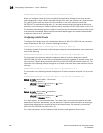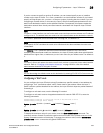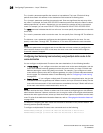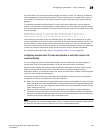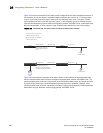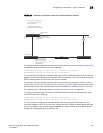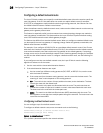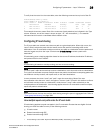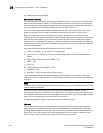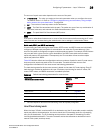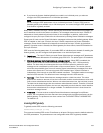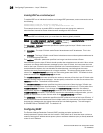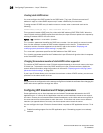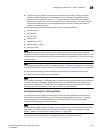
830 PowerConnect B-Series FCX Configuration Guide
53-1002266-01
Configuring IP parameters – Layer 3 Switches
26
• Routes learned through BGP4
Administrative distance
The administrative distance is a unique value associated with each type (source) of IP route. Each
path has an administrative distance. The administrative distance is not used when performing IP
load sharing, but the administrative distance is used when evaluating multiple equal-cost paths to
the same destination from different sources, such as RIP, OSPF and so on.
The value of the administrative distance is determined by the source of the route. The Layer 3
Switch is configured with a unique administrative distance value for each IP route source.
When the software receives multiple paths to the same destination and the paths are from
different sources, the software compares the administrative distances of the paths and selects the
path with the lowest distance. The software then places the path with the lowest administrative
distance in the IP route table. For example, if the Layer 3 Switch has a path learned from OSPF and
a path learned from RIP for a given destination, only the path with the lower administrative distance
enters the IP route table.
Here are the default administrative distances on the Layer 3 Switch:
• Directly connected – 0 (this value is not configurable)
• Static IP route – 1 (applies to all static routes, including default routes and default network
routes)
• Exterior Border Gateway Protocol (EBGP) – 20
• OSPF – 110
• RIP – 120
• Interior Gateway Protocol (IBGP) – 200
• Local BGP – 200
• Unknown – 255 (the router will not use this route)
Lower administrative distances are preferred over higher distances. For example, if the router
receives routes for the same network from OSPF and from RIP, the router will prefer the OSPF route
by default.
NOTE
You can change the administrative distances individually. Refer to the configuration chapter for the
route source for information.
Since the software selects only the path with the lowest administrative distance, and the
administrative distance is determined by the path source, IP load sharing does not apply to paths
from different route sources. IP load sharing applies only when the IP route table contains multiple
paths to the same destination, from the same IP route source.
IP load sharing does not apply to paths that come from different sources.
Path cost
The cost parameter provides a common basis of comparison for selecting from among multiple
paths to a given destination. Each path in the IP route table has a cost. When the IP route table
contains multiple paths to a destination, the Layer 3 Switch chooses the path with the lowest cost.
When the IP route table contains more than one path with the lowest cost to a destination, the
Layer 3 Switch uses IP load sharing to select one of the lowest-cost paths.



